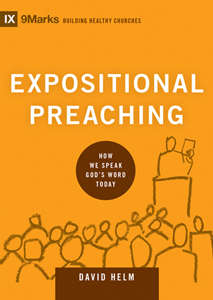 David Helm begins his fabulous little book Expositional Preaching with a portrait of the great Charles Simeon.
David Helm begins his fabulous little book Expositional Preaching with a portrait of the great Charles Simeon.
Helm says Simeon’s preaching “had something that much of our preaching lacks.” What might that be? “Simeon believed,” Helm writes, “that a simple and clear explication of the Bible is what makes a church healthy and happy. Biblical exposition does the heavy lifting of building a church.”
Simeon once said,
My endeavor is to bring out of Scripture what is there, and not to thrust in what I think might be there. I have a great jealousy on this head; never to speak more or less than I believe to be the mind of the Spirit in the passage I am expounding.
And this is exactly what is lacking in so much of the popular preaching today. Helm says we need preaching “committed to staying on the line, never rising above the text of Scripture to say more than it said and never falling beneath the text by lessening its force and fullness.”
WHAT EXPOSITION REALLY IS
Many of us experientially know how spot on Helm is. We have sat through preaching that claimed to be expositional, but was far from the true ideal. Sure, the preacher was sequentially walking through a book of the Bible, but lectio continua does not make one an expositor. It is oh so easy to take a text and pull out from it something that isn’t there. Maybe it is the classic “right doctrine from the wrong text,” or it is increasingly likely that a preacher using the text a launching pad for personal musings on just about everything.
One thing that will protect us against unintended imposition on the text is a clear, and right, understanding of what expositional preaching really is. David Helm’s definition is as good as I’ve come across. He says,
Expositional preaching is empowered preaching that rightly submits the shape and emphasis of the sermon to the shape and emphasis of the biblical text.
The strength of his definition, for me at least, is his employment of “shape and emphasis.” If the sermon gets this right then you can bet it brings out of the text what the Holy Spirit put there, not what the preacher thinks is there.
WHAT EXPOSITION SOUNDS LIKE
Paying attention to shape and emphasis bears significantly on structure and delivery. For example, I recently preached a sermon on Mark 14:12-31 where the author employs one of his favorite literary sandwiches. Three sections in the text meant three divisions in the sermon. I could have easily come up with five divisions, but at that point my sermon is not as clearly reflecting the shape of the text. Furthermore, this Markan sandwich exists to emphasize the self-sacrifice of Christ that is announced in the Lord’s Supper. So, my attempt to mirror the text’s emphasis meant devoting most of my explanation and application to 14:22-25.
Now, we ought to mention how much tone comes into play in this understanding of exposition. If comforting promises fill the text, our tone ought to have distinct warmth and sympathy. If threatenings or judgments are emphasized, our voice must have prophetic courage. This kind of attention to emphasis protects the preacher from becoming a one-chord band. Ican point you to many a preacher who are like Creed or Nickleback; no matter the content the song always sounds the same.
STIR ‘EM UP
Decades after his ordination Charles Simeon reflected on his early preaching ministry by saying,
I undertook the care of [of a friend’s church] and I have reason to hope that some good was done there. In the space of a month or six weeks the church became quite crowded; the Lord’s Table was attended by three times the usual number of communicants, and a considerable stir was made among the dry bones. (quoted in Helm, 111).
Work hard this week in your preparation to feed God’s sheep. Labor to rightly submit the shape and emphasis of your sermon to the shape and emphasis of the text. Then go and make a considerable stir among the dry bones.
